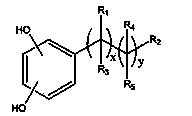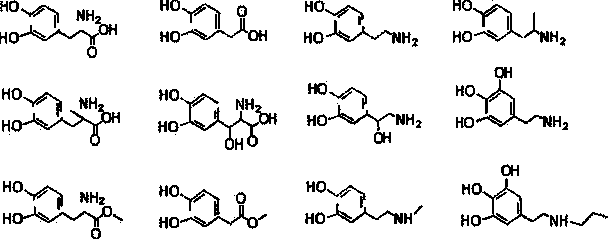Method of in-situ generation of nano particle on separating membrane surface
A nanoparticle, in-situ generation technology, applied in the field of separation membrane, to achieve the effect of simple preparation method, easy operation of the preparation method, and long-lasting effect
- Summary
- Abstract
- Description
- Claims
- Application Information
AI Technical Summary
Problems solved by technology
Method used
Image
Examples
Embodiment 1-5
[0026] Soak the polysulfone ultrafiltration membrane in 10 mmol / L Tris (TRIS) hydrochloric acid buffer solution (pH8.5) (20% isopropanol aqueous solution) for 30 minutes, then add dopamine at a concentration of 10 mg / L mL. Stir or shake the solution continuously (1 minute, 20 minutes, 30 minutes, 40 minutes, 60 minutes), take out the ultrafiltration membrane, and wash it repeatedly with 20% isopropanol aqueous solution to remove unreacted dopamine and unattached polydopamine. Then soak the polydopamine-coated polysulfone ultrafiltration membrane in a 1000 mmol / L silver nitrate solution for 5 minutes (at room temperature), and after cleaning the excess silver nitrate, dry the polysulfone membrane naturally and test the surface contact angle And the formation of silver nanoparticles was observed by scanning electron microscope. The surface contact angle of the polydopamine-modified polysulfone membrane decreased significantly, and decreased significantly with the coating tim...
Embodiment 6-10
[0028] Soak the ultrafiltration membrane PVDF in 10 mmol / L Tris (TRIS) hydrochloric acid buffer solution (pH 8.5) (containing 25% isopropanol solution) for 2 hours, then add dopamine at a concentration of 2 mg / mL. Stir or shake the solution continuously (2 hours, 4 hours, 8 hours, 16 hours, 32 hours), take out the ultrafiltration membrane, and wash it repeatedly with pure water to remove unreacted dopamine and unattached polydopamine . Then soak the PVDF ultrafiltration membrane coated with polydopamine in 5000 mmol / L copper sulfate solution for 12 hours (at room temperature), and then wash the excess copper sulfate, and use the Dead-End device to test the water of PVDF ultrafiltration membrane. Flux, water flux was found to decrease with prolonged dopamine coating time. Scanning electron microscopy shows that copper nanoparticles grow on the surface of the PVDF ultrafiltration membrane and in the nanopores, and the size of the copper nanoparticles is 20-100 nanometers. ...
Embodiment 11-14
[0030] Soak the polypropylene microfiltration membrane in 50% ethanol aqueous solution, then add dopamine at a concentration of 1 mg / mL, and add potassium persulfate (0.5 mg / mL). Stir or shake the solution continuously for 48 hours, take out the microfiltration membrane, and wash it repeatedly with 50% ethanol aqueous solution to remove unreacted dopamine and unattached polydopamine. Then soak the polydopamine-coated microfiltration membrane in zinc sulfate solutions of different concentrations (51 mMol / L, 100 mMol / L, 500 mMol / L, 1 Mol / L) for 24 hours (room temperature), and then wash the excess After the salt solution, the microfiltration membrane was dried naturally, and the surface contact angle was tested. The results showed that after the growth of zinc nanoparticles, the surface contact angle of the film decreased with the increase of zinc salt concentration. The surface contact angles are 60, 58, 45, 40 degrees, respectively. The surface hydrophilicity of the microfil...
PUM
| Property | Measurement | Unit |
|---|---|---|
| concentration | aaaaa | aaaaa |
Abstract
Description
Claims
Application Information
 Login to View More
Login to View More - R&D
- Intellectual Property
- Life Sciences
- Materials
- Tech Scout
- Unparalleled Data Quality
- Higher Quality Content
- 60% Fewer Hallucinations
Browse by: Latest US Patents, China's latest patents, Technical Efficacy Thesaurus, Application Domain, Technology Topic, Popular Technical Reports.
© 2025 PatSnap. All rights reserved.Legal|Privacy policy|Modern Slavery Act Transparency Statement|Sitemap|About US| Contact US: help@patsnap.com



